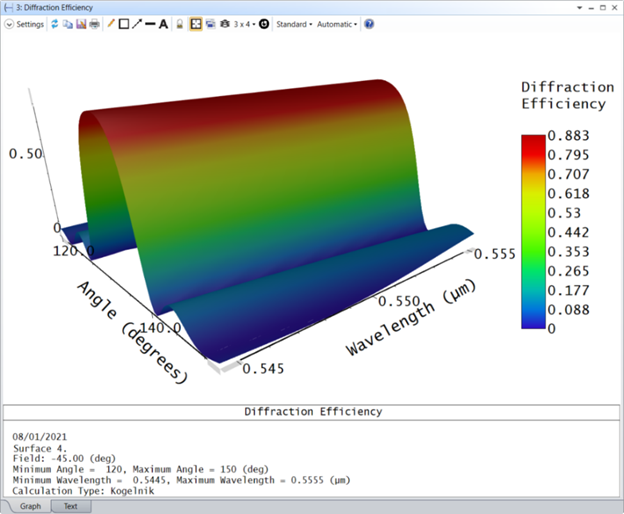Released: January 19th, 2021
1 Tools, Features, and Capabilities
1.1 Native Volume Holograms (All Editions) and Diffraction Efficiency Analysis (Professional and Premium Editions, Subscription Only)
Volume holograms and their analysis are now natively supported in Sequential Mode.
This release brings new native volume holograms and Diffraction Efficiency analysis tools to Sequential Mode that were previously only possible using DLLs. This allows the full simulation of volume holographic gratings in Sequential Mode by considering properties such as material shrinkage and index shift. Now it is possible to calculate diffraction efficiency using Kogelnik’s method for thick holograms and to simulate images. There are 3 new analyses available: Efficiency vs. Angle, Efficiency vs. Wavelength, and Diffraction Efficiency. To find these new analysis tools, select Analyze > Diffraction Efficiency.

Volume holograms and their analysis are supported for Hologram 1, Hologram 2, Toroidal Hologram, and Optically Fabricated Hologram surfaces in Sequential Mode by the addition of new surface parameters. Details of these new parameters can be found in Help and in the newly updated Knowledgebase Article Simulating diffraction efficiency of a volume holographic grating using Kogelnik’s method.
1.2 New Roll Tolerance Operands (All Editions)
Six new roll operands make it easier to tolerance bonded elements.
OpticStudio 21.1 features six new roll operands: TRLX, TRLY, TRLR, TARX, TARY, and TARR. These are designed for tolerancing bonded components, where elements can be cemented out of alignment creating a roll between the surfaces in contact.
These new roll operands model this misalignment as a rotation about a surface’s center-of-curvature. The minimum or maximum roll can be quantified as either total indicator runout (TIR) or as the angle between the optical elements.
1.3 New Radial Decenter Tolerance Operands (All Editions)
Two new radial decenter operands designed for systems with circular optics.
Two new decenter operands: TEDR and TSDR for tolerancing elements and surfaces respectively, expand on the existing decenter operands in OpticStudio by adding the ability to decenter along a random radial axis. This is recommended when modelling circular optics in circular mounts such as traditional camera lenses or microscope objectives where the existing Cartesian decenter operands could cause a bias towards the 45° diagonals between the X and Y axes.
2 Feature Experiments
2.1 New Optimization Methods (All Editions)
New DLSX and PSD optimization methods have been added.
DLSX (streamlined DLS) and PSD (pseudo-second derivative) optimization methods have been added for use with Local, Global and Hammer optimizations. To activate this Feature Experiment, select Help > Feature Experiments > New Local Optimization Methods.
2.2 Enhanced Wide Angle Ray Aiming (All Editions)
Improves speed and stability of ray aiming in wide angle systems.
This Feature Experiment improves ray aiming if either Paraxial or Real Ray Aiming is enabled in System Explorer. Most of the improvement in speed and stability also requires Robust Ray Aiming to be enabled. This will have the greatest effect on wide angle lenses, off-axis systems and lenses starting with an aspherical element. To activate this Feature Experiment, select Help > Feature Experiments > Enhanced Wide Angle Ray Aiming.
3 Programming
3.1 ZOS-API: Diffraction Efficiency Analysis (Professional and Premium Editions, Subscription Only)
The ZOS-API includes new Diffraction Efficiency features.
The three new Diffraction Efficiency analyses are all available through the ZOS-API.
4 Libraries and Catalogs
4.1 Catalog Updates (All Editions)
Get the latest catalogs from NHG, CDGM, SUMITA, Hubei Gabrielle-Optech, Applied Optics, RPO, and EKSMA Optics.
Material Catalogs
- The NHG catalog has 10 new materials added and some performance data updated.
- The CDGM catalog has been updated to include 16 new glasses. Also 62 glasses have been updated to use the Sellmeier 1 formula with an extended index range and 3 glasses are now marked Obsolete. Melt Frequency, Relative Cost and Status have been updated for the whole catalog.
- The SUMITA catalog has 3 new glasses added with properties of 3 further glasses updated.
- A new catalog named GBJ from Hubei Gabrielle-Optech Co., Ltd has been added.
Test Plate Lists
- The Applied test plate file has been updated.
Lens Catalogs
- The RPO catalog has been updated to include 4 new lenses: A260, A280 A635, and A658.
- The EKSMA OPTICS catalog has new lenses added including FemtoLine Thin Lenses.
Coating Catalog
- The COATING.DAT Coating File has been updated with additional comments to include more information on the formatting of data within the file.
5 Performance and Stability Improvements
OpticStudio 21.1 includes the following improvements:
- Source Diffractive - Stability improvements when using Source Diffractive in Non-Sequential Mode.
- Zemax License Manager – Check HASP Drivers function updated to Check & Repair HASP Drivers.
- Quick Yield – Added support for TEZI and TEXI operands.
6 Bug Fixes
OpticStudio 21.1 includes the following bug fixes:
- GRIN – Fixed an issue with GRIN materials in the Single Ray Trace and Polarization Ray Trace where the individual ray was using the local vertex refractive index and not the refractive index at the ray intercept. This only affected the reported direction cosine at the given surface and did not affect the actual GRIN trace to the image plane.
- Spot Diagram – Spot Diagram now correctly displays the units in afocal mode. Calculations are not affected.
- Optimization Operands – Optimization operand ACOS (arc cosine) input now rounds input values greater than +1.0 and less than -1.0 to exactly +1.0 or -1.0 respectively before taking the arc cosine of the input value.
- Prepare for OpticsBuilder – The Prepare for OpticsBuilder tool now correctly shows the Position Tolerance in Lens Units.
- Single Ray Trace – Improvements in reporting the correct signs for the direction cosine in MIRROR space when using global coordinates. This extends on the corrected signs to polarization ray tracing, Merit Function operands and ZPL numeric functions. Local ray tracing and results are not affected by this improvement.
- Zemax Black Box – Improved handling of vignetted rays inside a ZBB Black Box file.
- Layout Plots – Fixed a bug in sag rendering for Q-Type Freeforms in layout plots. This bug did not affect the ray trace algorithm.
- Interferogram – Fixed behavior in the Interferogram analysis settings which caused all values to reset to their defaults when pressing F3 or clicking the Undo button.



